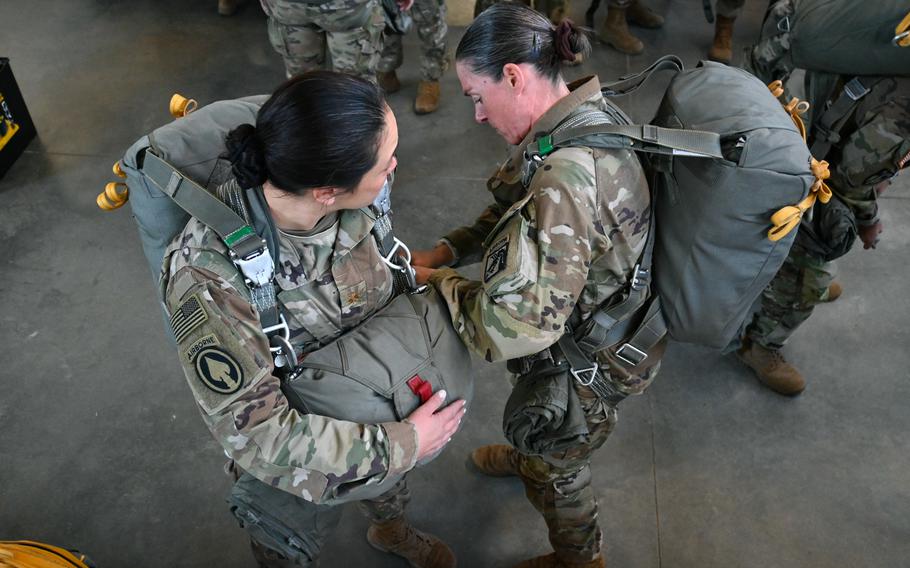
Maj. Talisa Dauz (left) and Sgt. Maj. Jennifer McAlluliffe (right), XVIII Airborne Corps, help each other get rigged up for an all-female airborne jump in honor of International Women's Day, March 13, 2023. The all-female jump is an annual tradition for many Army units. (Erin Conway/U.S. Army)
Fewer women are choosing to join the Army as the largest military branch struggles through another difficult recruiting year, according to data from the service.
Army recruitment overall has dropped more than 29% since the coronavirus pandemic began in March 2020, with female enlistments down by 31% during the same time, according to data that the Army provided to the Defense Advisory Committee on Women in the Services at its most recent meeting.
“Female prospects view the Army as an inferior employer — neither aligned with their aspirations nor providing desired outcomes,” according to the Army’s slide presentation to the committee, which has provided the Pentagon with recommendations for more than 70 years on how to address the challenges women face when serving in the military.
Only about 8% of women ages 16 to 24 have a propensity to serve in the military, according to a Defense Department document provided to the advisory committee, which will hold its next meeting June 27.
Though the crisis of sexual assault and harassment in the military attracts a lot of attention, Lory Manning, a retired Navy captain and board co-chairperson of the nonprofit Service Women’s Action Network, said it’s not the only factor that affects a woman’s decision to join the service.
“The Army has the biggest need for both men and women. It's [by] far the biggest service, so their recruiting job is harder, particularly in times when there's good employment opportunities in the civilian community,” she said.
Manning also said the Army could be falling behind in recruiting women because women might be choosing other service branches.
“In some ways, at least in some people's minds, it's kind of glamorous to be in the Marines or the Navy, or the Air Force or Space Force. The Army is something that I don’t think is ever viewed as glamorous,” she said.
The Army is struggling overall to attract enough recruits.
Last year, the service fell about 15,000 recruits short of its goal of 60,000. This year, the service set a goal of 65,000 recruits and projects it will fall short again.
The Army presentation made in March to the women’s advisory committee might also point to another factor — the service does not assign recruiting goals based on gender or racial or ethnic background.
But retention remains high in the Army. Sgt. Maj. of the Army Michael Grinston, the top enlisted soldier in the service, said Wednesday that the service has already met its goal this year for the number of soldiers it wanted to keep in the ranks.
More so, women are increasingly becoming a larger percentage of the active-duty force despite enlistments being down.
In 2010, women were 13.4% of active-duty soldiers. That percentage has grown slowly each year and has held at 15.5% since 2020.
To combat the drop in recruiting among women, the Army told the advisory committee that it has increased its number of female recruiters and expanded the locations where they work. It also has recruiters who speak 24 different languages, the service said.
The Army has also established a new Women’s Initiative Team to advocate for female soldiers, said Madison Bonzo, an Army spokeswoman.
“This team, composed of [active-duty], [National] Guard and Reserve soldiers along with civilians will advocate for Army policy, program, and resource changes to set conditions for success in women’s recruitment, retention, readiness, health, well-being, empowerment and advancement across the total Army,” she said.
To attract more young women interested in talking to a recruiter, Manning said she would find a way to share the good news stories of female soldiers and target recruiting to certain demographics of women, such as athletes. Many young women don’t realize the variety of occupations available in the Army.
“If you target the recruiting right at them, when they see somebody who looks like them, they say, ‘Hey, there's a woman here,’” she said.